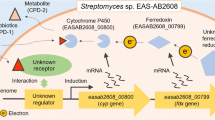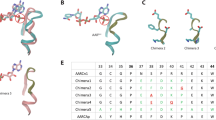Abstract
Daidzein C6 hydroxylase (6-DH, nfa12130), which is a class I type of cytochrome P450 enzyme, catalyzes a hydroxylation reaction at the C6-position of the daidzein A-ring and requires auxiliary electron transfer proteins. Current utilization of cytochrome P450 (CYP) enzymes is limited by low coupling efficiency, which necessitates extramolecular electron transfers, and low driving forces, which derive electron flows from tightly regulated NADPH redox balances into the heterogeneous CYP catalytic cycle. To overcome such limitations, the heme domain of the 6-DH enzyme was genetically fused with the NADPH-reductase domain of self-sufficient CYP102D1 to enhance electron transfer efficiencies through intramolecular electron transfer and switching cofactor preference from NADH into NADPH. 6-DH-reductase fusion enzyme displayed distinct spectral properties of both flavoprotein and heme proteins and catalyzed daidzein hydroxylation more efficiently with a k cat/K m value of 120.3 ± 11.5 [103 M−1 s−1], which was about three times higher than that of the 6-DH-FdxC-FdrA reconstituted system. Moreover, to obtain a higher redox driving force, a Streptomyces avermitilis host system was developed for heterologous expression of fusion 6-DH enzyme and whole cell biotransformation of daidzein. The whole cell reaction using the final recombinant strain, S. avermitilisΔcyp105D7::fusion 6-DH (nfa12130), resulted in 8.3 ± 1.4 % of 6-OHD yield from 25.4 mg/L of daidzein.







Similar content being viewed by others
References
Agarwal AK, Auchus RJ (2005) Minireview: cellular redox state regulates hydroxysteroid dehydrogenase activity and intracellular hormone potency. Endocrinology 146(6):2531–2538
Bartek T, Blombach B, Zonnchen E, Makus P, Lang S, Eikmanns BJ, Oldiges M (2010) Importance of NADPH supply for improved L-valine formation in Corynebacterium glutamicum. Biotechnol Prog 26(2):361–371
Bernhardt R (2006) Cytochromes P450 as versatile biocatalysts. J Biotechnol 124(1):128–145
Blank LM, Ebert BE, Buehler K, Buhler B (2010) Redox biocatalysis and metabolism: molecular mechanisms and metabolic network analysis. Antioxid Redox Signal 13(3):349–394
Budde M, Maurer SC, Schmid RD, Urlacher VB (2004) Cloning, expression and characterisation of CYP102A2, a self-sufficient P450 monooxygenase from Bacillus subtilis. Appl Microbiol Biotechnol 66(2):180–186
Buhler B, Park JB, Blank LM, Schmid A (2008) NADH availability limits asymmetric biocatalytic epoxidation in a growing recombinant Escherichia coli strain. Appl Environ Microbiol 74(5):1436–1446
Chin JW, Cirino PC (2011) Improved NADPH supply for xylitol production by engineered Escherichia coli with glycolytic mutations. Biotechnol Prog 27(2):333–341
Chin JW, Khankal R, Monroe CA, Maranas CD, Cirino PC (2009) Analysis of NADPH supply during xylitol production by engineered Escherichia coli. Biotechnol Bioeng 102(1):209–220
Choi KY, Jung E, Jung DH, An BR, Pandey BP, Yun H, Sung C, Park HY, Kim BG (2012a) Engineering of daidzein 3′-hydroxylase P450 enzyme into catalytically self-sufficient cytochrome P450. Microb Cell Factories 11:81
Choi KY, Jung E, Jung DH, Pandey BP, Yun H, Park HY, Kazlauskas RJ, Kim BG (2012b) Cloning, expression and characterization of CYP102D1, a self-sufficient P450 monooxygenase from Streptomyces avermitilis. FEBS J 279(9):1650–1662
Choi KY, Kim TJ, Koh SK, Roh CH, Pandey BP, Lee N, Kim BG (2009) A-ring ortho-specific monohydroxylation of daidzein by cytochrome P450s of Nocardia farcinica IFM10152. Biotechnol J 4(11):1586–1595
Chowdhary PK, Alemseghed M, Haines DC (2007) Cloning, expression and characterization of a fast self-sufficient P450: CYP102A5 from Bacillus cereus. Arch Biochem Biophys 468(1):32–43
De Mot R, Parret AH (2002) A novel class of self-sufficient cytochrome P450 monooxygenases in prokaryotes. Trends Microbiol 10(11):502–508
Dietrich M, Eiben S, Asta C, Do TA, Pleiss J, Urlacher VB (2008) Cloning, expression and characterisation of CYP102A7, a self-sufficient P450 monooxygenase from Bacillus licheniformis. Appl Microbiol Biotechnol 79(6):931–940
Dodhia VR, Fantuzzi A, Gilardi G (2006) Engineering human cytochrome P450 enzymes into catalytically self-sufficient chimeras using molecular Lego. J Biol Inorg Chem 11(7):903–916
Fasan R, Chen MM, Crook NC, Arnold FH (2007) Engineered alkane-hydroxylating cytochrome P450(BM3) exhibiting nativelike catalytic properties. Angew Chem Int Ed Engl 46(44):8414–8418
Fasan R, Crook NC, Peters MW, Meinhold P, Buelter T, Landwehr M, Cirino PC, Arnold FH (2011) Improved product-per-glucose yields in P450-dependent propane biotransformations using engineered Escherichia coli. Biotechnol Bioeng 108(3):500–510
Girvan HM, Seward HE, Toogood HS, Cheesman MR, Leys D, Munro AW (2007) Structural and spectroscopic characterization of P450 BM3 mutants with unprecedented P450 heme iron ligand sets. New heme ligation states influence conformational equilibria in P450 BM3. J Biol Chem 282(1):564–572
Gonzalez RJ, Tarloff JB (2001) Evaluation of hepatic subcellular fractions for Alamar blue and MTT reductase activity. Toxicol In Vitro 15(3):257–259
Goto H, Terao Y, Akai S (2009) Synthesis of various kinds of isoflavones, isoflavanes, and biphenyl-ketones and their 1,1-diphenyl-2-picrylhydrazyl radical-scavenging activities. Chem Pharm Bull (Tokyo) 57(4):346–360
Grogan G (2011) Cytochromes P450: exploiting diversity and enabling application as biocatalysts. Curr Opin Chem Biol 15(2):241–248
Haga T, Hirakawa H, Nagamune T (2013) Fine tuning of spatial arrangement of enzymes in a PCNA-mediated multienzyme complex using a rigid poly-L-proline linker. PLoS ONE 8(9):e75114
Hannemann F, Bichet A, Ewen KM, Bernhardt R (2007) Cytochrome P450 systems—biological variations of electron transport chains. Biochim Biophys Acta 1770(3):330–344
Hung TV, Ishida K, Parajuli N, Liou K, Lee HC, Sohng JK (2006) Enhanced clavulanic acid production in Streptomyces clavuligerus NRRL3585 by overexpression of regulatory genes. Biotechnol Bioproc Eng 11(2):116–120
Ishikawa J, Yamashita A, Mikami Y, Hoshino Y, Kurita H, Hotta K, Shiba T, Hattori M (2004) The complete genomic sequence of Nocardia farcinica IFM 10152. Proc Natl Acad Sci U S A 101(41):14925–14930
Kille S, Zilly FE, Acevedo JP, Reetz MT (2011) Regio- and stereoselectivity of P450-catalysed hydroxylation of steroids controlled by laboratory evolution. Nat Chem 3(9):738–743
Lamb DC, Ikeda H, Nelson DR, Ishikawa J, Skaug T, Jackson C, Omura S, Waterman MR, Kelly SL (2003) Cytochrome p450 complement (CYPome) of the avermectin-producer Streptomyces avermitilis and comparison to that of Streptomyces coelicolor A3(2). Biochem Biophys Res Commun 307(3):610–619
Lee WH, Kim MD, Jin YS, Seo JH (2013) Engineering of NADPH regenerators in Escherichia coli for enhanced biotransformation. Appl Microbiol Biotechnol 97(7):2761–2772
McLean KJ, Girvan HM, Munro AW (2007) Cytochrome P450/redox partner fusion enzymes: biotechnological and toxicological prospects. Expert Opin Drug Metab Toxicol 3(6):847–863
McLean KJ, Sabri M, Marshall KR, Lawson RJ, Lewis DG, Clift D, Balding PR, Dunford AJ, Warman AJ, McVey JP, Quinn AM, Sutcliffe MJ, Scrutton NS, Munro AW (2005) Biodiversity of cytochrome P450 redox systems. Biochem Soc Trans 33(Pt 4):796–801
Munro AW, Girvan HM, McLean KJ (2007) Cytochrome P450—redox partner fusion enzymes. Biochim Biophys Acta 1770(3):345–359
O’Reilly E, Kohler V, Flitsch SL, Turner NJ (2011) Cytochromes P450 as useful biocatalysts: addressing the limitations. Chem Commun (Camb) 47(9):2490–2501
Omura T, Sato R (1964) The carbon monoxide-binding pigment of liver microsomes. II. Solubilization, purification, and properties. J Biol Chem 239:2379–2385
Otey CR, Landwehr M, Endelman JB, Hiraga K, Bloom JD, Arnold FH (2006) Structure-guided recombination creates an artificial family of cytochromes P450. PLoS Biol 4(5):e112
Pandey BP, Roh C, Choi KY, Lee N, Kim EJ, Ko S, Kim T, Yun H, Kim BG (2010) Regioselective hydroxylation of daidzein using P450 (CYP105D7) from Streptomyces avermitilis MA4680. Biotechnol Bioeng 105(4):697–704
Park JS, Kim DH, Lee JK, Lee JY, Kim HK, Lee HJ, Kim HC (2010) Natural ortho-dihydroxyisoflavone derivatives from aged Korean fermented soybean paste as potent tyrosinase and melanin formation inhibitors. Bioorg Med Chem Lett 20(3):1162–1164
Park JS, Park HY, Kim DH, Kim HK (2008) Ortho-dihydroxyisoflavone derivatives from aged Doenjang (Korean fermented soypaste) and its radical scavenging activity. Bioorg Med Chem Lett 18(18):5006–5009
Peters MW, Meinhold P, Glieder A, Arnold FH (2003) Regio- and enantioselective alkane hydroxylation with engineered cytochromes P450 BM-3. J Am Chem Soc 125(44):13442–13450
Robin A, Roberts GA, Kisch J, Sabbadin F, Grogan G, Bruce N, Turner NJ, Flitsch SL (2009) Engineering and improvement of the efficiency of a chimeric [P450cam-RhFRed reductase domain] enzyme. Chem Commun (Camb)(18):2478-80
Sadeghi SJGG (2013) Chimeric P450 enzymes: activity of artificial redox fusions driven by different reductases for biotechnological applications. Biotechnol Appl Biochem 60(1):102–110
Schuckel J, Rylott EL, Grogan G, Bruce NC (2012) A gene-fusion approach to enabling plant cytochromes p450 for biocatalysis. Chembiochem 13(18):2758–2763
Tee KL, Schwaneberg U (2006) A screening system for the directed evolution of epoxygenases: importance of position 184 in P450 BM3 for stereoselective styrene epoxidation. Angew Chem Int Ed Engl 45(32):5380–5383
Urlacher VB, Eiben S (2006) Cytochrome P450 monooxygenases: perspectives for synthetic application. Trends Biotechnol 24(7):324–330
Ying W (2008) NAD+/NADH and NADP+/NADPH in cellular functions and cell death: regulation and biological consequences. Antioxid Redox Signal 10(2):179–206
Zhang JD, Li AT, Yu HL, Imanaka T, Xu JH (2011) Synthesis of optically pure S-sulfoxide by Escherichia coli transformant cells coexpressing the P450 monooxygenase and glucose dehydrogenase genes. J Ind Microbiol Biotechnol 38(5):633–641
Acknowledgments
This work was supported by the Intelligent Synthetic Biology Center of Global Frontier Project funded by the Ministry of Science, ICT&Future Planning (2013060084). And this work was also partially supported by the Energy Efficiency & Resources of the Korea Institute of Energy Technology Evaluation and Planning (KETEP) grant funded by the Korea Government Ministry of Trade, Industry and Energy (20133030000300) and Polar Academic Program (PAP, PD13010) from KOPRI. We thank Prof. Hattori from Kitasato University in Japan for donating Nocardia farcinica IFM10152.
Author information
Authors and Affiliations
Corresponding author
Rights and permissions
About this article
Cite this article
Choi, KY., Jung, E., Yun, H. et al. Engineering class I cytochrome P450 by gene fusion with NADPH-dependent reductase and S. avermitilis host development for daidzein biotransformation. Appl Microbiol Biotechnol 98, 8191–8200 (2014). https://doi.org/10.1007/s00253-014-5706-7
Received:
Revised:
Accepted:
Published:
Issue Date:
DOI: https://doi.org/10.1007/s00253-014-5706-7




